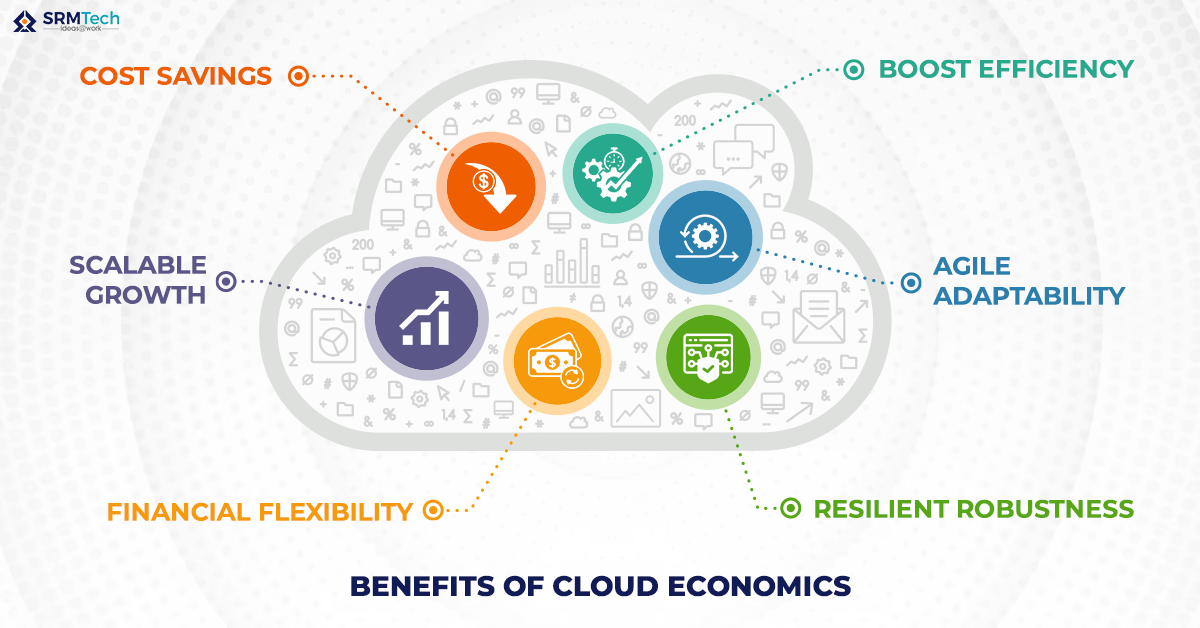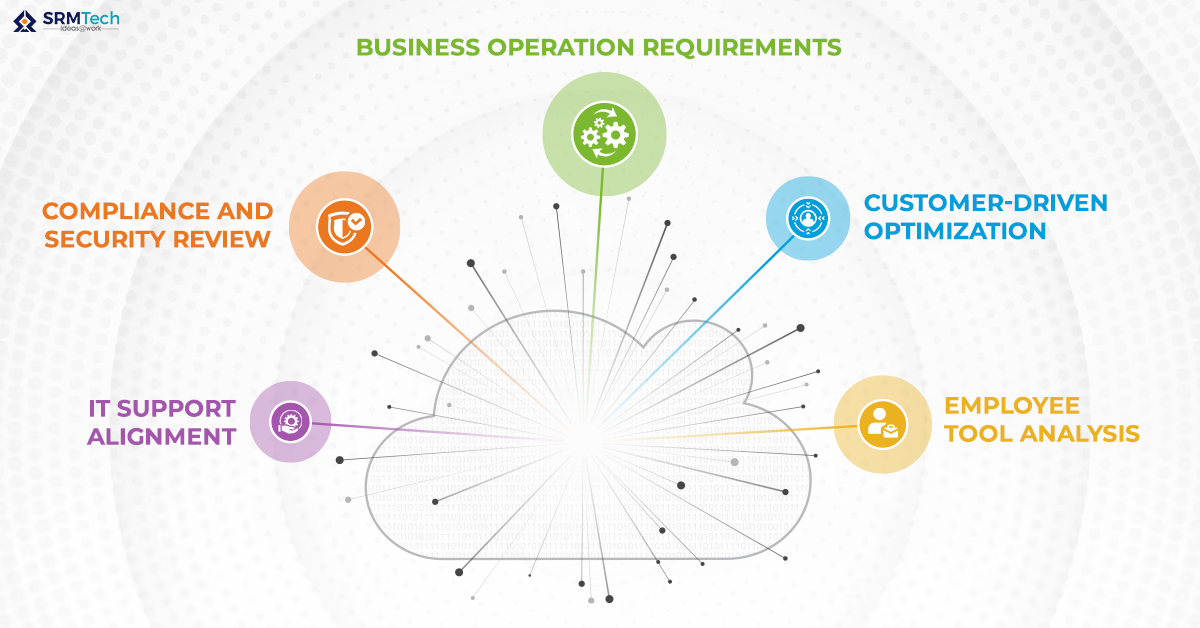The notion of driving digital initiatives only through on-premise data centers could increase IT cost centers and budgeting, hindering the business’s overall ROI. Hence, the adoption of cloud computing becomes imperative, offering a solution to this dilemma while also bolstering cost-effectiveness.
We are now traversing through a time when most organizations are significantly moving towards cloud computing, partly or wholly – which offers them numerous benefits like impressive scalability, business agility, and innovation by providing on-demand delivery of databases, storage, computing power, applications, and other IT services. This means you only pay for what you need and when you use it. To ensure effective spending on cloud services, organizations need to familiarize themselves with the concept of the Cloud Economy.
Read on to explore more on cloud economics.
Understanding Cloud Economics and the Role of Cloud Economists
Cloud Economics refers to the financial analysis and evaluation of implementing cloud technologies and services to determine their cost-effectiveness and value for an organization. It involves assessing various factors, such as the total cost of ownership (TCO), scalability, cost savings, flexibility, and resource management.
Cloud economists are cross-functional professionals who work closely with CIOs, IT leaders, and finance teams to assess the economic implications of moving to cloud services and platforms. They deeply understand cloud infrastructure, platform offerings, pricing models, and the specific financial considerations related to cloud migration. These experts are crucial in helping organizations make informed decisions about adopting and optimizing cloud solutions to best serve their business goals.
Cloud Economists generally analyze existing infrastructure costs, compare them with cloud service costs, and identify potential cost savings and operational efficiencies by employing a wide range of cloud economics tools to make optimal and cost-efficient decisions. They also consider compliance, data security, and performance to ensure that the chosen cloud solutions align with the organization’s operational requirements and budget expectations.
Simply put, cloud economists act as trusted advisors who bring a unique blend of financial expertise, technical knowledge, and business acumen. Cloud economists’ insights and analysis enable businesses to maximize cost savings, adopt scalable solutions, and drive innovation by employing the best cloud cost management strategies.
Benefits of Cloud Economics

The Exciting Potential of Cloud Economics for Your Organization
Organizations embracing the cloud and opting for cloud economics strategies are poised to experience significant advantages over just monetary impact, as the cloud brings a whole range of benefits that can revolutionize the way you do business.
Let us see how the cloud and cloud economics in 2024 benefit your business.
Efficiency
Cloud economics enables organizations to enjoy increased efficiency through cloud resources, allowing efficient collaboration, supporting DevOps practices, and facilitating automatic data integration into apps. Furthermore, by choosing the right-fit cloud-powered solutions with the help of cloud economics, you can transform digital workflows, ensure efficient performance across your business operations, and experience outstanding results.
Resilience
Cloud providers enable operational resiliency through redundant infrastructure and security measures in a more cost-efficient approach. With demonstrated service-level agreements, businesses can easily rely on cloud platforms to ensure uninterrupted services. Cloud providers generally spread workloads across several data centers geographically, offering business continuity and optimal performance. In addition, sophisticated security protocols secure business systems while instilling data integrity.
Business Agility
Businesses can achieve remarkable economies of scale in cloud storage and computing platforms. For instance, an app development team can quickly provision new computing resources to test and release updates under dynamic demand scenarios. Whether managing temporary surges in network traffic during peak seasons or facilitating steady growth, a proper cloud economics strategy enables operational flexibility for businesses to become more competitive and stay on top of their game.
Cost-Effectiveness
Now, let’s talk about the true power of cloud economics – the cost benefits of cloud computing. Did you know that migrating to the public cloud can reduce your Total Cost of Ownership (TCO) by up to 40%? Just imagine the impact on your organization’s finances! You can substantially reduce costs while enjoying improved flexibility, scalability, and resource management.
What is TCO?
Cloud economics revolves around the notion of TCO. This means considering all the costs associated with running a data center, such as building expenses, power and cooling systems, networking costs, hardware and software expenses, IT personnel salaries and benefits, maintenance and support fees, and energy usage. By accurately evaluating the TCO, you can compare the costs of on-premises solutions to cloud solutions and make the most cost-effective choice for your organization through cloud economics.
CapEx to OpEx Switch
Cloud economics revolves around the notion of TCO. This means considering all the costs associated with running a data center, such as building expenses, power and cooling systems, networking costs, hardware and software expenses, IT personnel salaries and benefits, maintenance and support fees, and energy usage. By accurately evaluating the TCO, you can compare the costs of on-premises solutions to cloud solutions and make the most cost-effective choice for your organization through cloud economics.
In many organizations, there is a noticeable trend toward shifting from capital expenses (CapEx) to operating expenses (OpEx) to reap the benefits of cloud computing’s cost-effectiveness. CapEx typically involves long-term asset investments, while OpEx covers ongoing operational costs paid periodically.
The present pay-as-you-go model (implicating OpEx), a core aspect of cloud economics, significantly accelerates the cloud transition. By embracing cloud solutions, businesses can conserve their budgets by avoiding upfront investments and paying for services as and when needed. As we already know, the economics of scaling in cloud computing allow businesses to dynamically adjust resources to match demand, optimizing cost-efficiency and performance.
CapEx to OpEx Switch
This approach offers both cost efficiency and flexibility, allowing companies to scale resources dynamically without the burden of owning and managing on-premise infrastructure. For startups, this definitely helps as they do not have upfront money for Capex; it also helps the big giant MNCs make revised business and financial decisions.
Questions to ask for Effective Cloud Economics Analysis for your Organization
Cloud economics gives IT teams actionable insights into what’s needed now and in the future.
Here’s what you should ask when analyzing cloud economics:

- Firstly, what are the specific needs of your internal operations teams that can be addressed through cloud services? This is important to ensure they have everything they require to do their job effectively.
- Next, how can we use cloud computing to meet our customers’ needs while optimizing our cloud economics? This is exciting because it allows you to provide better service and support to your customers cost-efficiently.
- Another consideration is whether you need extended IT support for your organization’s products or services to work effectively within the framework of cloud strategy. It’s essential to ensure your cloud economics planning includes appropriate resources in place to provide a seamless experience for your customers.
- You should also find out which cloud-based tools your employees are using. This provides essential insights on investing and leveraging the tools that accelerate your workforce collaboration and productivity.
- Finally, are there any compliance or regulatory factors that need to be addressed in the cloud? This is crucial as you must ensure you’re meeting all requirements and maintaining the highest level of data integrity.
Nevertheless, it’s a significant and crucial analysis for your organization’s growth and success with perfectly chosen cloud economics strategies.
How to Craft a Compelling Business Case for Cloud Economics
As we delve into the economic advantages of migrating to the cloud, you must always tailor your pitch to best suit your organization’s needs. Whether you’re a government agency, a tech startup, or an established corporation, the cloud has the potential to boost flexibility and reduce budgets. However, the extent of these benefits depends on how well you execute the migration process with effective cloud economics planning and strategy. Below are the mandatory business cases to attain the best from cloud economics.
Assessing Current Data Center Expenditures
Let’s start by examining your current data center expenses. This includes software, hardware, maintenance, and operational costs. When calculating potential savings, remember to factor in additional expenses like technical resources and licensing fees.
Planning the Migration Process
How will your migration to the cloud unfold? The process can differ for each organization. Consider whether you’ll transition gradually, in phases, or all at once with planned downtime and backup strategies in place. Remember to factor in the time needed to test your applications on the newer infrastructure and platforms. Also, consider whether your cloud transition includes your custom and in-house applications.
Anticipating Monthly Cloud Expenses
Once the migration planning is complete, it’s time to anticipate your monthly cloud expenses. You can thoroughly understand projected costs by analyzing past usage and upcoming activity. In addition to estimated pricing from the cloud provider, your budget projections should incorporate expenses like management efforts and technical training.
Contrasting Computing Costs
Here’s where we see a significant contrast between traditional and cloud environments. In conventional IT setups, businesses can easily predict and plan for computing costs. Expenses are typically fixed, and companies pay the required computing capacity upfront. This allows for a straightforward calculation of the total cost of ownership over time. On the other hand, cloud providers operate on a pay-as-you-go model, eliminating the need for upfront commitments in most services. While this saves on initial capital investments, it requires careful cost management to avoid overspending.
Implementing Cost Optimization Strategies
After you contrast the cost of traditional setup and using the cloud, establishing and implementing cost optimization strategies is crucial for cloud economics to prevent overspending on cloud resources. For example, CloudZero offers a cost intelligence platform that can track migration expenses to AWS and provide insights for reducing your overall bill. These efforts can significantly benefit your business in the long run by efficiently leveraging cloud platforms.
Eliminating Over-Provisioning with Cloud Elasticity
In traditional setups, businesses often over-provision computing capacity to cover potential busy periods, which can be costly. However, cloud computing overcomes this scenario through cloud elasticity. Most cloud service providers offer platforms that enable you to utilize resources dynamically, ensuring you only pay for what you use. This increases cost efficiency and allows for effective resource management and optimization, which fosters better cloud economics.
Wrapping Up
Now, with the elaborated exploration of business cases and thoughtful considerations for cloud economics, it’s time to get on your cloud adoption journey and reap the significant business benefits that await. Remember to tailor your approach to your organization’s specific needs and make informed decisions every step of the way.
If your organization is embarking on a cloud journey, we are here to assist you in developing a cloud budget, examining operational benefits, evaluating cloud services, predicting future improvements, and ultimately navigating toward a growth-centric cloud adoption. Connect with our cloud engineering experts today to know how you can accelerate your cloud adoption with an appropriate cloud economics strategy, fostering improved agility and cost-efficiency in your digital infrastructure management.






